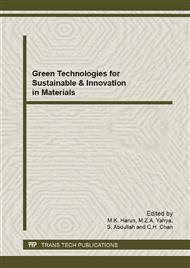p.261
p.266
p.275
p.280
p.285
p.290
p.296
p.305
p.313
Physical Properties of the Amorphous Silica Encapsulated Fluorescence Dye
Abstract:
Amorphous nanosilica entrapped fluorescence dye intended to be used as tracing agent for imaging of cell or tissue in human cell was prepared using micelle entrapment approach. Micelles were produced by mixing a surfactant in water with additives such as butanol and ammonia in a preheated bioreactor. Then, 1,1%-dioctadecyl-3,3,3%,3% tetramethylindocarbocyanine perchlorate (DiI) dye tracing agent was added into the mixture followed by the addition of silica precursor. The parameters studied including effect of surfactant amount, effect of temperature and amount of Si precursor. Silica encapsulated DiI produced were then characterized using Transmission Electron Microscope (TEM), X-ray diffraction (XRD) and UV-Vis NIR spectrophotometer. Dynamic light scattering (DLS) showed that tunable size of nanoparticles in the range of 30-150 nm can be produced by varying synthesis parameters. The results showed that the silica encapsulated DiI became bigger and uniform in size with the increase of temperature and amount of surfactant. The silica encapsulated with DiI is photostable which the intensity of fluorescence value is 279.12 after 90 minutes exposure to halogen lamp (200W) compared to bare DiI that degraded to 100.61.
Info:
Periodical:
Pages:
285-289
Citation:
Online since:
April 2013
Keywords:
Price:
Сopyright:
© 2013 Trans Tech Publications Ltd. All Rights Reserved
Share:
Citation:


